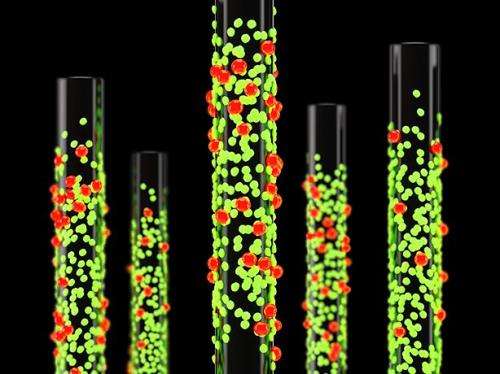March 25, 2014 weblog
Lab-on-fiber could shine light on disease

(Phys.org) —"Imagine turning on your home lab kit, pricking your finger, and blotting the blood on an array of fiber probes. In just a few minutes, the machine would automatically e-mail the results to your doctor, who could get back to you within hours if there was a problem. Meanwhile, you could get on with the rest of your day." This is the scenario painted in a detailed essay in IEEE Spectrum of what the future might hold, according to Jacques Albert, who heads the Advanced Photonic Components group at Carleton University in Ottawa, Canada.
Albert's team together with collaborating groups around the globe, including the Université de Mons in Belgium and Jinan University in China, are working on the lab-on-fiber, that is, the use of optical glass fibers as platforms for chemical sensors. This is an approach to bringing on a more affordable mobile labs system in which chemical sensors do the monitoring. Optical glass fibers hold the key to labs on fiber with their tiny diameter yet huge information-carrying capacity and dirt-cheap cost, said Albert.
Attempts to develop labs with components that are cheap and portable have been evident for many years. Lab-on-a-chip sensors have looked promising, he wrote, but obstacles have stood in the way of progress; he gave examples such as a chip's metal conductors that may corrode or short, or the chip having arsenic, toxic to humans. Another drawback he said has been size. Albert also said some researchers seek to replace a chip's electronic circuits with optical ones.
"By using light rather than current to read chemical reactions, a photonic chip works reliably in aqueous solutions, is immune to electromagnetic radiation, tolerates a wide range of temperatures, and poses fewer risks to biological tissues." A photonic lab on a chip, however, has not been any magic bullet either, he said, because of size and expense.
Instead, Albert made a case for what his team and colleagues are developing, a lab on fiber. He said, "We coat this probe with a chemical compound, called a reagent, that will interact with whatever target molecules we want to measure, such as blood enzymes or food additives."
Ultimately, they aim to develop a lab on fiber that can be inserted directly into humans to monitor biological changes realtime.
"We are currently planning experiments—first in test tubes and eventually in animals—to see if a fiber probe can detect metastasized cancer cells in the bloodstream. We hope to shed light (literally) on the process by which these cells invade other organs."
The team also hopes their work leads to developments in scanner screening technologies less invasive than tools such as biopsies. He posed an example where a doctor may insert a fiber probe into a blood vessel using a hypodermic needle. "no more painful than a flu shot."
Nonetheless, further developments will be necessary before such ideas materialize. He said it likely will be at least five years before lab-on-fiber instruments are ready for commercial use. One challenge is to figure out how to toughen the probes' surface coating so they can be stored for several months without becoming unstable and losing their ability to bind with target molecules.
More information: via IEEE Spectrum
© 2014 Phys.org


















